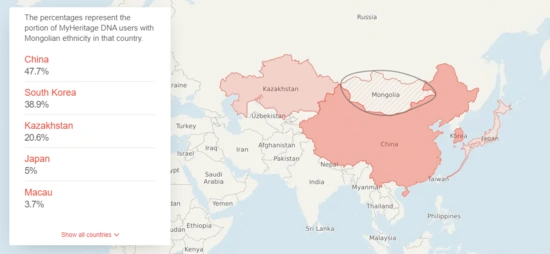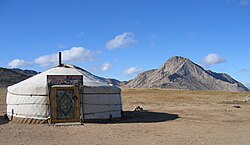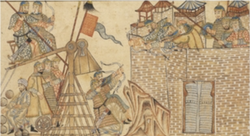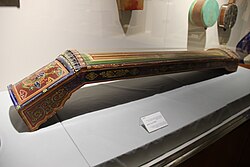
By the first millennium B.C.E., the nomadic tribes collectively known as proto-Mongols roamed the Mongolian Plateau in North Asia, a vast expanse encompassing modern Mongolia and parts of Northern China. By the eleventh–twelfth centuries, the various bands of people roaming the deserts, mountains, and grasslands of Mongolia were of sufficient ethnic, linguistic, and cultural similarity to be uniformly regarded as Mongolians. The Mongol Empire famously swept through Eurasia, facilitating a circulation of people, goods, and ideas such as the world had never seen before. Today, Mongolians make up approximately 95% of Mongolia’s population of 3.1 million people. Approximately 4.2 million Mongolians live in Inner Mongolia, an autonomous region in Northern China, making up just over 17% of the mostly Han Chinese population. Russia also houses a sizeable Mongolian diaspora.
Research your ancestors on MyHeritage
Mongolian history
The first description of a potentially proto-Mongol peoples comes from ancient Chinese sources, which tell of a nomadic group — called the Xiongnu — that dominated the steppes of northeast Central Asia between the third century B.C.E. and the first century C.E. The Xiongnu were among the five peoples who rebelled against the Chinese Jin dynasty between 304–316 B.C.E., carving out an independent kingdom in what is now northern China. In the first century C.E., the Chinese Han dynasty successfully pushed the Xiongnu back into the Altai Mountains and the steppes north of the vast Gobi Desert. Concurrently, the Xianbei and Wuhuan — proto-Mongolic peoples who had for a period been conquered by the Xiongnu — moved into the area in Northern China vacated by the retreating Xiongnu. The Northern Wei Dynasty (386–533), descended from the Xianbei, jostled frequently with the proto-Mongol Rouran Khaganate (330–555), which ruled over large swaths of Mongolia and Northern China.

In the sixth century, the Göktürks — a Turkic tribal confederation inhabiting the Altai Mountains — revolted and overthrew their Rouran overlords, establishing themselves as a major power in North and Inner Asia until the late eighth century. Another Turkic people, the Uyghurs, formed an alliance with the Chinese Tang dynasty: the Uyghurs subdued the Khitan, a semi-nomadic proto-Mongol people, and successfully conquered and ruled much of western and northern Mongolia until the ninth century. Following the collapse of the Uyghur Empire, the Khitan began a spectacular period of expansion which saw them establish the Liao dynasty (916–1125), ruling over eastern Mongolia, most of Manchuria, and the Sixteen Prefectures of northern China. The Jurchen, a Tungusic people, formed an alliance with the Chinese Song dynasty and successfully invaded the Liao, forcing its ruler to flee. The ousted leader allied with the Uyghurs and established the Qara Khitai state in modern Kazakhstan. Meanwhile, the Golden Kings of the Jurchen Jin faced a new menace: an emerging leader named Temujin, who for the first time successfully united all clans on the Mongolian plateau, earning him the honorary title — Genghis Khan. United under the leadership of Genghis Khan, the Mongols struck out in every direction, east to Chinese lands and west towards the Qara Khitai and the Muslim sultanates across Central Asia, Iran, Afghanistan, and parts of Iraq. Genghis Khan died of natural causes in 1227 while at war against the Xi Xia in northwestern China. His son, Ogedai, expanded the empire even farther into Chinese and Russian territories. Ogedai was the last strong ruler of the empire, but despite his death in 1241, the empire expanded further into Vietnam in the east, and the Balkans and Eastern Europe in the west. In 1258, the Mongols sacked Baghdad, bringing an end to the Abbasid Caliphate and the Islamic Golden Age. By 1270, the Mongol Empire had become the largest contiguous empire in world history.

Following the death of Möngke Khan in 1259, no Great Khan would ever again wield authority over the entirety of the Mongol Empire, which fractured into four autonomous khanates: The Golden Horde in Eastern Europe, the Ilkhanate in the Middle East, the Chagatai Khanate in Central Asia, and the Yuan dynasty – seated in modern-day Beijing – in East Asia. Having succumbed to the Golden Horde in the fourteenth century, the lands of the Ilkhanate eventually came under the sway of the Turkish Ottoman and Persian Safavid empires. In the fifteenth century, the Golden Horde splintered further into smaller khanates, ultimately united by the Muscovy Rus’: a predecessor of the Russian Empire. During the fourteenth century, the Chagatai Khanate lost Transoxiana to the legendary Turkic conqueror Tamerlane. The last Chagatai Khan was removed from what was left of the khanate’s territories in 1705. The dispersed Mongolian people of the former khanates quickly adopted and were assimilated into the Turkic and Persian cultures surrounding them.
After finally ousting the Chinese Song dynasty in 1276 and quelling the last Chinese resistance in 1279, the Yuan dynasty ruled all of China for about a century, until the rise of the Chinese Ming dynasty in South China in 1368. The Mongols retreated to their homeland, establishing the Northern Yuan dynasty. During the sixteenth century, Buddhism became the official religion of the previously shamanistic Mongols. Turbulent politics saw the Northern Yuan dynasty split into Western Mongolia and Eastern Mongolia, which in turn was further divided, until finally succumbing to the Chinese Qing dynasty, which would rule over Mongolia until the twentieth century.

In the early twentieth century, a mass colonization of Mongolian lands by Han Chinese people, orchestrated by the Qing government, inspired a wave of Mongolian nationalism, culminating in the Mongolian Revolution in 1911. However, true independence from the Republic of China would take another decade, coming only in 1921 with the military support of the Soviet Red Army. In 1924, the Mongolian People’s Republic was proclaimed, ushering in a seventy-year period of communist rule in Mongolia. Inspired by the glasnost and perestroika in the Soviet Union, and the collapse of communist regimes in Eastern Europe, Mongolia renounced communism, adopted democracy, and transitioned to a market economy in the 1990s. Today, Mongolia is a vibrant multi-party democracy, and one of the world’s fastest-growing economies.
Mongolian culture
The Mongol nomads were masters of horse-borne mobility, fearsome warriors whose lightning-like raids and clouds of arrows have become the stuff of legends. Alongside masterful archery, physical fitness, and notorious ruthlessness, it was supreme horsemanship (and possession of almost half of the world’s population of horses!) which enabled Mongol warriors to sweep through Eurasia between the Twelfth-thirteenth centuries. Horses have been an inseparable part of Mongol culture: horses ridden in battle were never killed for food, and when old or lame, were retired to pasture to live out their last days. Today, Mongol horses are cultivated for milk, meat, labor, and racing. Indeed, horse racing is one of the most popular sports in Mongolia, echoing a national ethos: “the nomad is born in the saddle.”

The nomadic way of life is still practiced today in rural areas. Pastoral nomads raise and breed livestock, migrating from place to place following seasonally favorable pastures and campsites. The products the livestock pastoralist nomads raise on the steppes stand at the heart of the Mongolian diet, which relies heavily on meat and dairy products. The Mongolian ger (also known as yurt) — a portable circular dwelling made of wooden rods lashed together with leather thongs and covered in felt — remains the home of Mongolian nomads. Traditional Mongolian music employs a range of instruments and applications of the human voice that are truly unique — none more so than khoomei (Mongolian throat singing), in which the performer produces a guttural pitch and, simultaneously, one or more pitches above it. In 2009, khoomei was inscribed on the Representative List of the Intangible Cultural Heritage of Humanity of UNESCO.
Every summer, the traditions of Mongol culture come together during the festival of Naadam, also known as eriin gurvan naadam (“the three games of men”). During Naadam, the games of Mongolian wrestling, horse racing, and archery are held throughout the country. The festival is probably the most well-known among Mongolian festivals, and in 2010 was also inscribed on the Representative List of the Intangible Cultural Heritage of Humanity of UNESCO.
Mongolian languages
With over 5 million native speakers, Mongolian — the official language of Mongolia — is the most widely spoken of the Mongolic language family. Despite the long-standing usage of the Cyrillic alphabet, the traditional and unique Mongolian script — written down the page in vertical lines — is slowly being reintroduced. Russian is the most common foreign language in Mongolia, although English is rapidly replacing it as the nation’s second language.
Explore more about ethnicity estimates
- MyHeritage DNA at MyHeritage
- Ethnicities around the world at MyHeritage
- What Is My Ethnicity? How MyHeritage Estimates Ethnicities at MyHeritage Knowledge Base
- Where's My Ethnicity?!: Why An Ethnicity Might Not Show Up In Your DNA (and How To Find Evidence Of It Anyway) at MyHeritage Knowledge Base


